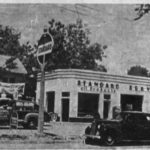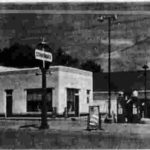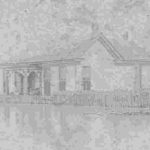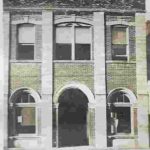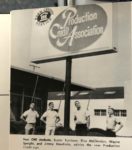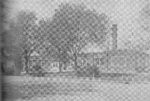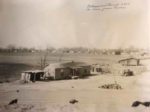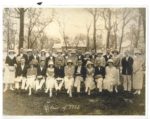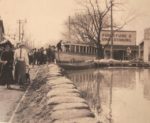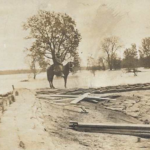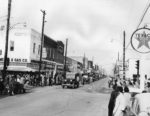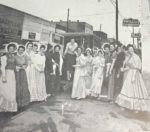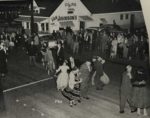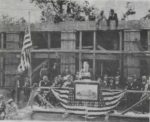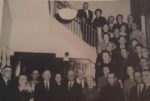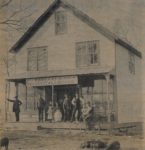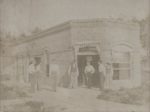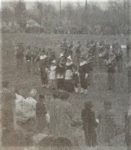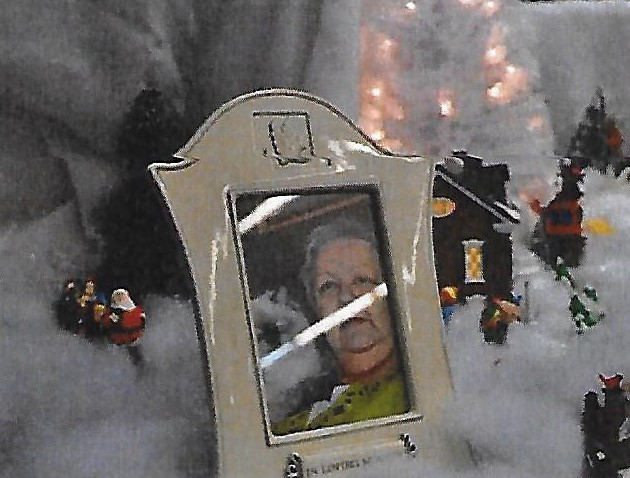Throwback Pictures from Facebook – 2021
In May of 1948, Caruthersville was celebrating the addition of a “downtown” Standard station to join the “uptown” station at 11th Street and Ward. Managers for the new station were Bob Gardner and Shirley Neff (who later was manager at the local J.C. Penney Store).
These pictures were taken in 1897 in Gayoso. Caruthersville Public Library recently acquired a collection of photos of both Gayoso and Hayti that were taken by members of the Dorris family. (This photo says “Mollie Dorris 1897” in pencil on the back of it – yet another reason it is so important for families to label their family photos.)
In 1898, Gayoso was being threatened by the Mississippi River eroding its banks and encroaching on what was then the county seat of Pemiscot County. An election was held and, even though Hayti was closer to the location of Gayoso, the larger number of voters in Caruthersville brought the county seat here. All records were moved to this city in 1899.
This was the Caruthersville City Hall in 1913. It was located on West Third Street, as it is now, but closer to the river – in the vicinity of the bank parking lot. It served the city until 1961 when the present Muicipal Building in Caruthersville was dedicated at the former site of Frisco Park.
With the opening of Grizzly Jig in its new location on Truman, today we are featuring a drawing of the original occupant of the corner of East Third and Ward Avenue – the Cunningham Store Company.
This post is long, but gives the reader an idea of the style of writing from the early 20th century. Especially note what the only two items were that this store did not sell.
In a business directory “Pemiscot County Missouri – Describing its Resources, Enterprises, and Opportunities and the Men Behind Them” from 1919:
“The evidence of the rapid growth of Caruthersville into one of the leading cities of Southeast Missouri and the general business prosperity of the community is symbolized in the upbuilding of the Cunningham Store Company, located on Ward Avenue and Third Street.
This is one of the pioneer mercantile establishments of Caruthersville, having been established away back in 1892, and was conducted under the style of Cunningham Brothers until June 16, 1903, at which time the Cunningham Store Company was organized.
The store is a credit to its owners as well as to the city. The main salesroom is 70×150 feet in size, with an L 50×70 feet and is equipped throughout with modern fixtures and filled to overflowing with everything in the line of general merchandise of the better quality. They also utilize another building at the rear of the main salesroom which is 70×90 feet in size and two stories in height. This structure is used for the storage of farm implements and heavy goods and they also have a large implement yard adjoining these buildings.
They handle everything for the comfort and convenience of the community they serve. Included in their stock may be found dry goods, notions, clothing, furnishings, hats, shoes, ladies’ ready-to-wear garments, millinery, staple and fancy groceries, hardware, farm implements, household necessities, furniture, stoves, ranges, etc. In fact, everything except drugs and coffins.
In all departments they require the services of about 18 clerks and assistants, and patrons are shown the best of attention on all occasions.
Handling a very heavy stock of high grade goods, quoting moderate prices and adhering to straightforward methods, this company has been the means, in a great measure, of keeping Caruthersville trade at home where it belongs and a laudable spirit of home patronage is evidenced more and more each season than heretofore because of the splendid advantages presented by this concern to the shopping public of the community.
The gentlemen at the head of this enterprise have devoted the greater part of their lives to mercantile pursuits and know just what to buy and where to buy in order to meet the demands of all classes of people.
The company is incorporated under the laws of the State with the following wide-awake, public spirited and progressive business men at its head: C. L. Cunningham, President; P. J. Cunningham, Vice-President; Tom M. Smith, Secretary; C. H. Cunningham, Treasurer; and J.A. Cunningham, Manager. These gentlemen are among the leading financial citizens of Pemiscot County and their names are closely allied with the commercial and agricultural development of this community.
These four young men – Buster Turnbow, Elva Ray McClendon, Wayne Speight, and Jimmy Hendricks – “staged” a yearbook photo in the early 1960s, pointing out the new sign at Production Credit Association on West Third Street, which commemorated their 30th anniversary of assisting with farm loans in Caruthersville.
This photo of early Hayti was received in the Gayoso pictures that we recently acquired. Here in a picture around 1900, flood waters covered the main street downtown since a levee to hold back the Mississippi had not yet been constructed. The names on some of the businesses at that time are clearly seen.
On the 10th anniversary of the new Caruthersville High School that opened on February 18, 2011 – and to give attention to the historic snowfall we have dealt with over the past week, here are three of the iconic “snowfall” pictures of the “old” CHS that graced a number of the high school yearbooks over the years.
A quote accompanying one of these pictures read: “And we remember how our school appeared to us in the winter…the first big snowfall settling quietly over the campus…the footprints of frolicking teen-agers making a pattern on its smooth surface…these scenes are a part of our memories of life at CHS.”
(As a bonus, you can catch of glimpse of Kay Malin Snow, the hardest working librarian at Caruthersville Public Library in one of these photos.)
Mrs. Marie Chappell’s 3rd grade at what was then Westside Elementary during the 1958-1959 school year are shown in a class picture.
Identified are first row (l-r) Nita Malone, ? Kwajalein Green, Vickie Townsend, ?, and ?; second row (l-r) ?, Donnie Peeler, Terri Michie, Phillip ?, Susan Andrews, Johnny Griffy, Marvin ?, and Mike Odom; third row (l-r) Mrs. Chappell, ?, Keith Robertson, Paul Grubbs, Sharon Worth, Tommy Thrasher, Kay Malin, Sherry Hemphill, ? and ?
If you can recognize any of these 3rd graders who weren’t identified, feel free to let us know their names.
Featured here is an eighth-grade graduation program from the Caruthersville Grammar School in 1934. Note that it was held in the morning at 10 a.m. You may be able to recognize some of the names, as well as the handwritten pencil notes beside them.
With the Mississippi River above flood stage in recent days, here is a look back to flooding in the early 1900s. These photos were from our recently acquired Gayoso collection, but at least a couple of them depict outside of Hayti (with the low levee and the railroad tracks).
These pictures show the former Central High School in Hayti from the front and back, as well as a picture of their gymnasium that was built in 1952-53.
The first school building was constructed in 1932. It had two rooms on the front, with two small rooms on each end. These small rooms were built for restrooms but could not be used due to the lack of a sewage system. The building had a large room across the back with a stage on the north end. This room was divided by two sets of folding doors, which when closed, formed 3 rooms.
In 1935, grades nine and ten were added and in 1939, the eleventh and twelfth grades completed the school.
Hayti Negro (Central) High school developed into the largest school for Blacks between Memphis, TN and St. Louis, MO. Less than 1,200 graduated from this school during its existence, but over 5,000 students attended.
In addition to serving the local community, students came from Steele, Hermondale, Gobler, Kennett, Malden, Wardell, Deering, Portageville and small farms all around the Bootheel. (Excerpt from the book “Our Story” by Iona Griggs Hollins. This book, in its entirety, is available on our website at cville.lib.mo.us or just Google Caruthersville Public Library. Direct link is http://cville.lib.mo.us/local-history/ Ms. Hollins gave her blessing for us to share it, as she wants to get the pictures and memories out to as many people as possible.)
As written on this photo, this is a shot of Cottonwood Point as it looked in 1955. From the number of homes in the background, it appeared that a number of people lived in the town at this point. Note the chickens in the foreground of the picture.
This picture shows Main Street in Hayti, looking toward the east, in 1918.
The Caruthersville Class of 1923 was photographed on the Eastwood Memorial Methodist Church yard. Class sponsor was Julia Hawkins (Mrs. N. C. Hawkins)
Seated left to right: Wendell Setzer, Louise Duffey, Maury Roberts, Kathryn Hale, Clement Nanson, Gladys Siler, Clay Garrett, Genevieve Bloker, Fred Watkins, and Julia Hawkins.
Standing left to right: Ruby Kelley, Hayes Gowen, Hester Hawkins, Lynn Moore, Helen Dillman, Edward Mulliniks, Sadie Williams, Leslie Morgan, Frances Aquino, Cratus Riley, Edith Wilks, Lowell Foster, Mary Alice Scott, Otho Pierce, Grace Amburgey, Byron McKay, and Helen Powell. J. L. Daniels was not pictured. (Photograph was donated to the Pemiscot County Historical Society by Frances Aquino Hiller, longtime Caruthersville teacher)
This picture was taken in Caruthersville during high water in 1913. LaForge Furniture and Undertaking is shown right behind the passenger boat.
With the water above flood stage at Caruthersville right now, here are some more flashbacks from past flooding on the Mississippi. The first picture shows a side view of the same LaForge business pictured last week. The other shows a man on horseback on the levee (made mainly of sandbags) south of Caruthersville in 1913
The October 14, 1949 issue of The Democrat-Argus featured an ad for Caruthersville Motor Company, where Mr. Joe B. Michie, the proprietor of the Stadium Cab Company discussed his pleasure with the Dodge and Plymouth autos he had purchased for his six taxi fleet from this dealership. Shown in the bottom photo are: (left to right) Robert Hundhausen, driver, Bill Carter, driver, Mr. Michie, owner and driver, Ralph Cheney, driver, and Bervis Bethel, driver.
Fire chief Charlie Jones brought the top picture to the Pemiscot County Historical Society meeting this month, showing the location of the Stadium Cab company, right outside of the Stadium Theater at 11th and Ward Avenue.
Sixty-four years ago this weekend – June 4-7, 1957 – the streets of downtown Caruthersville were packed with sightseers for the Caruthersville Centennial Parade. One hundred years of the city’s history was celebrated with events like a beard-growing contest, a pageant called “Legend of Caruthersville”, and a greased pig contest were held during the festivities. Many residents still remember the centennial weekend with fondness and amazement as they remember the huge crowd that thronged Ward Avenue.
We are featuring the Caruthersville Centennial in 1957 during June and here is a collection of photos, showing the “jail” for those who were clean-shaven, some of the costumes, and some of the methods of travel in the parade, horses and carriages.
This June we are featuring pictures of the Caruthersville Centennial that took place in June of 1957. These ladies showed off their period dresses, that were in many cases, homemade. How many of them do you recognize?
Completing our tribute to the Caruthersville Centennial in 1957, one of the highlights was a street dance on East 5th Street in front of the City Pig, owned and operated by Van Johnson for many years. (This location is now Lux & Luv.) Many residents came to dance and many more came to watch the dancers.
Sawyer’s Drug Store occupied the northwest corner of Fourth and Ward for many years. It was one of the oldest pharmacies in the city, coming into existence before 1917. This is one of the most recognizable buildings in downtown Caruthersville since the “bones” of the building have remained relatively constant from Sawyer’s through the ownership of the former Casino Aztar when they first moved to Caruthersville in the mid-1990s and it is now occupied by attorney Daniel Cornacchione. Seen also on the right is the building that housed Stanfield Jewelry for many years, which is now a hair salon.
Times have indeed changed since this photo from the early 1900s. Steele’s first oil company served in the manner shown – a horse-drawn vehicle loaded with fuel for customers. Today’s services are much different, but the need is still the same. This fuel was undoubtedly kerosene or “coal oil” used for lamps as light (both in the homes and later on the fronts of automobiles); in cooking to start fires; for pouring on fresh wounds; and for swallowing with sugar, believe it or not, to ease a sore throat. (Photo provided to the Pemiscot County Historical Society by Jo Alice Utley a number of years ago.)
Here is an overhead shot of the town of Bragg City taken around 1955. Labeled on the photo are the various businesses and important buildings – an interesting view of the past.
The initial settlement at Bragg City came into existence in 1894, following the construction of the Kennett to Caruthersville railroad, a branch line of the St. Louis and San Francisco Railroad. It was initially called Owl City, due to the hooting of owls in the woodland through which the railroad was built. The town was laid out in 1894 when the railroad was extended to that point.
Upon the establishment of a post office in 1915, it was renamed Clayroot after the nearby Clayroot Island between Little River and Elk Chute; A post office called Clayroot was established in 1911, and the name was changed again in 1917-1918 to Bragg City after W. G. Bragg of Kennett, who owned large tracts of land in the area.
In the 2010 census, Bragg City had a total of 149 inhabitants.
The Bootheel Antique Car Klub (B.A.C.K.) got its start in the early 1960s when a group of local men who collected old cars got together and decided to host an annual event, Trade and Trophy Days, and even race the cars on the old Fairgrounds track. It was always a big event and hundreds would come, not only to take part in the show with their collector car, but to be a spectator at the always-exciting races.
In 1956, Brownie Troop 168, led by Mrs. Elva Gilmore, visited Kasper’s Bakery and enjoyed their treats. Shown here are (front row, left to right) Phyllis McCormick, Donna Hensley, Carolyn Chilton, Becky Hinchey, Linda Robinson, Connie Swafford, Mary Farrow, and Karen Henley (back row) Mary Klemp, Susan Hubbard, Phyllis Williams, Juanita Joines, Margaret Ann Gilmore, and Chlora Proctor.
Kasper’s Bakery opened in 1948 by Herman and Georgia Kasper at 509 Ward Avenue. For many years, it was said that Kasper’s Bakery had the best donuts from St. Louis to New Orleans along the Mississippi River. On Saturdays during the summer, the Delta Queen would make stops in Caruthersville and the passengers would disembark and rush to the bakery to get fresh baked goods and donuts. Saturday nights would be a busy time for the bakery with shoppers stopping in late for goodies.
Thanksgiving and Christmas were the prominent holidays for the bakery with orders for cakes and pies piled high for the customers. Birthday cakes were ordered daily. Wedding cakes were a specialty and were carefully loaded for delivery to area church receptions.
Kasper’s Bakery, closed after Herman’s death in 1973, has been missed by many, especially the donuts, brownies and yum yums they offered. (History from “A Collection of Memories and Recipes from the Legendary Kasper’s Bakery” published in 2016. For more information, contact kasperbakerycookbook@yahoo.com)
This picture is of the officials of the old Pemiscot County Fair Association. It was taken by Gallian Studio at the 1923 fair. The fair, later renamed the American Legion Fair, was the highlight of the year in Pemiscot County until 1965, the last year of the fair’s existence.
Kneeling in the front row, left to right, are the little boy, Bob Dorsey, then W. H. Dorsey, Harry Ridgely, not known, W. M. Collins, and Whitey Paster, who was a racing official. In the back row, left to right, are Jeff Roland, Doc Davis, W. P. Robertson, not known, Frank Cunningham Sr., H. V. Litzelfelner, Judge Albert Pendleton of Kansas City, starter of the horse races, Judge H. C. Schult, John Scott, and Bob Sharp.
The fair brought as many as 10,000 people in a single day to Caruthersville to enjoy the rides, the exhibition hall, where quilts and jellies and jams were judged, the food tents where fed thousands of meals during the six-day run of the fair, the grandstand show, and, of course, the horse races..
The races were held on a half-mile oval dirt track with cars and trucks parked in the infield with people standing on them to see the races.
The grandstand was always full of spectators. The highlight of the fair’s history was in 1945, when President Harry S Truman, Missouri’s only U.S. president, came to the fair.
Other photos are a promotion flyer for the 1916 Fair and a later photo of the thousands of cars in the parking lot for the event.
W.A. Samford’s store in Holland and the Holland Bank are shown as they appeared in 1912, when the population was about 400.. It was during this time that Holland had several stores, hotels, doctors, and other evidence of an up and coming town. This little spot in the woods of Pemiscot County was originally known as Middleburg. The woods and the name of Middleburg disappeared and the families of J. C. Winters and J. W. Holland settled there in 1871 and the town took the latter family’s name.
The Holland depot, also, is a reminder of how it used to be. (The bulletin board on which arrivals and departures were once posted is seen to te right of the windows and a mailbox hangs at the left.) Oldtimers reported remembering when passenger trains made stops; when five people worked there, one of them a telegraph operator. Trains traveled on the Frisco tracks until the late 1900s, but passenger service had been discontinued years ago and the freight trains just passed through Holland.
S. E. Juden, publisher of the Pemiscot Argus and the grandfather of Mrs. Noel Dean, speaks at the laying of the cornerstone of the “new” Pemiscot County Courthouse in 1924. The background shows some of the framework that will be used in the construction.
This is how the north side of the Hayti square appeared in the early 1900s. (This is where Conran Memorial Library now lives.)
In late 1947 a new store – Toni, Inc. – opened as soon as it could find an available building in Caruthersville. Toni, Inc. was a modern department store and was located at 420 Ward Avenue, occupying the former location of the Bernstein Furniture Company (where The Golden Rule operated for many years). The store handled most clothing items, as well as piece goods, and merchandise for the home.
Managing the store was Owen H. (Tony) Ferris who came to Caruthersville in 1944 as manager of the J.C. Penney Company, where he stayed until December of 1946 when he conceived of the idea to organize a home-owned business in which he would be the active head.
It was written at the time that “Opening of a business of this sort is indicative of the forward trend in business circles in the Caruthersville community, which, as a community, has been showing real growth in recent months and years. And the attractiveness of this store, with the completeness of its merchandise coverage, gives still an added reason why people like – and do well – to come to Caruthersville to do their trading”.
The 1964 Caruthersville Post Office staff Christmas Party guests were: Mr. and Mrs. Bailey Brooks,Calvin Dunavant, Mr. and Mrs. W. F. James, Oscar Farrow, Mr. and Mrs. Oscar Tillman, Mr. and Mrs. J. W. Neeley, Murel Andrews, Jack Searles, Mr. and Mrs. Carl Malin, Mr. and Mrs. Albert Walker, Wade Southerland, Mr. and Mrs. John Butrum, Mr. and Mrs. EdTutt, Mr. and Mrs. Leo McAdams, Mr. and Mrs. Lee Ferrell,Mr. and Mrs. Lavanda White, Mr. and Mrs. James Bingham, and Mr. and Mrs. Charles Malin. (Not pictured were Mr. and Mrs. Gene McElyea)
In this picture from the early days of Steele, Hans Doerner looks out the window of the depot to see whether a railroad ticket-purchaser is coming his way.The platform on which several are standing served the gin(rear of the picture), the depot, and on down the street (at right you can see a corner of Johnson’s Store).
This building at one time housed Uncle Jess Thomas’s soda fountain, Donas Hinchey’s pool room and soda fountain, Estas Wright’s restaurant (He lived above), and John Wheelous’s restaurant, Another story about this building was when “Uncle” M and “Aunt” Sam Phillips lived upstairs and inadvertently gave little Jessie Wells some unhappy moments once when their daughter, Annie Phillips, was getting married up there – the youngster thought the bride was being forced to marry against her will. Not so, however, Annie Phillips Laden Taylor was the mother of Thomas Laden, Helen Laden Farmer, and Jackie Taylor Hahs.
The Cottonwood Point ferry is recognized by its high barge allowing it to dock easier at the steeper landing at Cottonwood. The Powell ferry at Caruthersville had a flatter deck and a more gentle approach for the landing there. Both ferries ceased operations on December 1, 1976 when the bridge opened.
John T. Gilliland’s Whitehall Store in Cooter is pictured here in the early days of the town.
A heart attack proved fatal to Gilliland at age 82 in 1935. He was one of the oldest and most prominent residents of Cooter and the south part of Pemiscot County. Mr. Gilliland came to Cooter around 1880, before there was a town. He was the first postmaster there, serving from 1889 to 1914. He also established the first sawmill and store there, one of which is pictured above. He homesteaded his farm and owned large land interests in this section of the county.
From the June 1, 1928 issue of the Democrat-Argus: George Myrick, for a number of years serving on the police force of this city, opened up his lunch stand at his home just outside the city limits on the Braggadocio Highway and is devoting his time and attention now on this trade.
How many remember the Do Drop Inn on Highway U, where White and Associates is today?
J. W. Carmean and his efficient bookkeeper, Mrs. Daphon Roland, are shown behind the counter of their well-stocked supply room at Caruthersville Building Materials Company, one of the oldest business concerns in the city, in 1948.
Located at 429 West Fourth Street in the city, it was still in the same location where it was when the business was launched in 1916. J. W. Carmean was one of the four local people who organized the Caruthersville Lumber Company, with E. G. Roland, C. F. Bloker, and Dr. W. A. Crockett. Mr. Roland assumed management of the business and conducted it for a good many years.
In the fall of 1917, Mr. Carmean and Mr. Roland bought the interests of the other two partners and maintained the business until 1923, when Mr. Carmean sold his share to Mr. Roland, the late Glen Vandivort, and Raymond Lemm. Mr. Roland, some years later, purchased the interests of the other two, while Mr. Carmean moved to Arkansas, where he engaged in a contracting business.
Mr. Roland then continued in sole charge of the lumber company until 1943, when he sold it to Mr. Carmean and the late Mr. B. O. Bennett and the name of the firm was changed to the Caruthersville Building Materials Company. Both men were former residents of the city and both returned to Caruthersville, with Mr. Bennett assuming immediate control on December 15, 1943, and his partner joining him some months later.
Mr. Bennett passed away in 1946 and Mr. Carmean took over his interest in the business and has conducted it since as sole owner and manager. He first came to the city from jackson, MO in 1907 and for several years was engaged in the concrete contracting business. Even today it is common to see the legend stamped on sidewalks at various places in town: “Carmean Did It” – a form of advertising which he practiced. While residing in Arkansas he did a good deal of contracting in the building of government structures and it was because of some unfinished business that his return to Caruthersville to be associated with Mr. Bennett was delayed.
It would be hard to estimate the number of buildings that the Caruthersville Building Materials Company or its predecessor firm has furnished building materials to construct in the community – dwellings, business ventures, churches, schools, farm homes, etc. using the lumber, concrete, brick, roofing, nails, hardware, doors, windows, paint and so on from this company. These structures stand as silent testimonials to the fine materials which went into them and monuments to the firm which furnished them. It enjoys an enviable reputation for always furnishing top quality materials and giving its customers fair treatment, all of which, added to the many other advantages not offered by other towns the size of Caruthersville, make this city a desirable place in which to trade or to make one’s home.
(This article was taken from the July 23, 1948 edition of the Democrat-Argus newspaper.)
These two pictures depict cotton fields full of cotton near Gayoso before 1900. The second shows the family hauling their cotton into town with a horse-drawn wagon.
The Highfill-Neifind Store – called Caruthersville’s Greatest Furniture Store – was located at 405 Ward Avenue in the McElvain block in Caruthersville and their slogan was “Everything for the Home”. This ad from November 8, 1918 tells of their great selection and sale of stoves and ranges. (In 1927, the merchandise and stock were sold to the successors of Highfill-Neifind, the Hubbard Furniture Company of Blytheville, where Paul Smith was the manager. In 1933, it became the Cooperman Furniture Company)
After World War I, in April of 1919, a battle tank was brought to Caruthersville on a special train from Kennett. The Chamber of Commerce sponsored a parade, which formed at the courthouse behind the tank, which operated under its own power on the streets of the city, with returned soldiers, sailors, and Marines in uniform. Every military man in Pemiscot County was requested to be present and “assist in this monster celebration”.
It was described as “the first and last chance of Pemiscot County citizens to see one of these famous Hun destroyers in action, manned with American Doughboys who saw actual service.”
Victory Loan speakers accompanied the tank and addressed the residents during the afternoon and evening. By special arrangement, every Caruthersville store and business house was closed from 2:00 until 6:00 to give the tank its due respect.
The Bank of Hayti was already in existence by the late 1800s/early 1900s. J. L. Dorris was one of the early bank presidents and this photo was a part of the collection of vintage photos acquired by this Pemiscot County Historical Society earlier this year.
An annual Thanksgiving event in Caruthersville for many years was the strong football rivalry game between the Caruthersville Tigers and the Kennett Indians. Thousands of people would attend the game each year. In this picture from 1952, some residents dressed up as pilgrims during the CHS band’s halftime show.
This classic Thanksgiving ad from November 26, 1925 presents best wishes from a popular pharmacy in Caruthersville at that time – Gill’s Drug Store.
A later news story, giving the history of Gill’s Drug Store, read as follows:
Many years ago, when saloons were on every corner and Ward Avenue was just a “soft road”, there came to Caruthersville a man who had dreams and visions of what, at some future date, this little town of ours would some day become. The young man, reared among the hills in Wayne County, came her direct from the metropolis of St. Louis and began his career in Caruthersville behind a drug counter. This young man was Clyde O. Gill.
Time passed; conditions changed – perhaps now and then Mr. Gill altered his dream-vision, but always he clung to the idea that Caruthersville was a good town in which to live. With this in mind, he purchased a half-interest in what was at that time known as the Cunningham Drug Store, and he and his partner, Larry Hill, changed the name to Gill-Hill Drug Co.
Through “good times” and “bad times”, this store fought on. Mr. Hill died several years ago and the business was purchased outright by Mr. Gill. As Caruthersville grew, so grew the business of Mr. Gill. New and larger quarters were necessary; a single move was made – to the adjoining building, which was purchased by Mr. Gill. (Location later described as “across the street from Piggly Wiggly’s, at the corner of 4th and Ward)
The Gill Drug Store carries a very complete line of drugs and drug sundries. In the front of the building at one side is a very large and sanitary fountain, whose “mahogany” and mirror, according to local history, once graced the bar of J. H. Elder in by-gone days. It probably is the only one in captivity continued in service as a part of a soft drinks emporium, and is very beautiful. From here, those cold drinks, ice cream, sandwiches, etc., which has distinguished Gill’s “Service with a Smile” are dispensed. and here, as in the prescription and sundries departments, only the best is to be had.”
In December, we will be doing trips down memory lane of Christmases past at Caruthersville Public Library. Here is a visit from Santa in 2015.
In 2016, Carrie Ann Hippler was the guest reader at our Christmas Storytime. Some
of these children are still our “library kids”, but look how much they have changed in five years.
of these children are still our “library kids”, but look how much they have changed in five years.
Former Mayor of Caruthersville Diane Sayre spent many happy years collecting Department 56 snow village items from the time she purchased her first piece at the Yarn It store in Caruthersville. She loved the thrill of the hunt and always found a particular piece that she wanted – something unique to represent Caruthersville: maybe a church, a school, a movie theater, a river boat or something else. Over the years, moving from house to house, Diane realized that her collection had outgrown its boundaries.
The idea of a public display began as part of the Caruthersville Area Arts Council’s “Enchanted Forest” at the Historic Caruthersville Public Library on Ward Avenue, which is now the city court building. It then made its way to the Armory and finally makes frequent appearances at the new Caruthersville Public Library.
These are pictures of the village from 2017 when it was on display here.
A bonus #tbt from the library as posted on December 18, 1925. Enjoy – and Merry Christmas from all of us at Caruthersville Public Library!
The “Christmas Queen of Caruthersville”, Diane Sayre, is shown here as a part of the Christmas village when it was displayed at Caruthersville Public Library in 2017.
A graduate of Caruthersville High School in 1965, Diane’s love for the city of Caruthersville included several terms as mayor of the city and allowed her to share the joy she gained from her Department 56 Snow Village pieces with the community. When selecting items for her collection, she always tried to find things that depicted businesses, institutions or buildings in the city. Even before her untimely death in 2013, she made plans for the Caruthersville Area Arts Council to continue her legacy with periodic viewings of the village. Upon her death, Show-Me Missouri publisher, Gary Figgins, a hometowner, wrote: “Our hometown has lost yet another person who spent a lifetime struggling against the forces that threaten to tear apart small-town America…nature, poverty, apathy. Caruthersville is far from being the “perfect” community, but it has withstood painful blows that would have been fatal to many other communities. That would not have been possible without the solid leadership of its mayor of nearly 30 years. “
